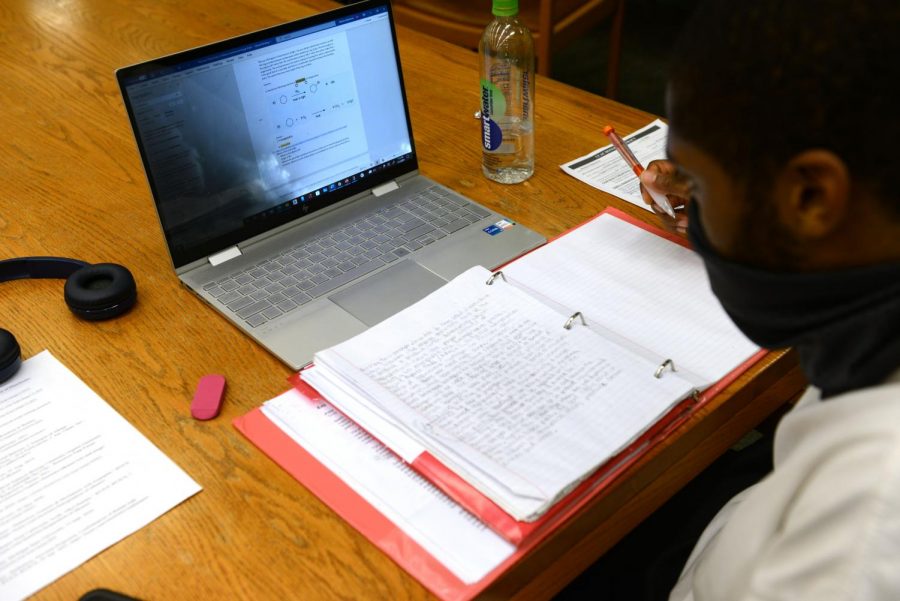Study finds that Pitt students’ mental, physical health still struggling one year into the pandemic
Clare Sheedy | Assistant Visual Editor
Montez Newsome, a junior mathematics-economics major, studies for an organic chemistry project at Hillman Library on Friday evening.
December 6, 2021
Despite loosened social distancing requirements, the start of in-person classes and activities at many universities and the availability of a COVID-19 vaccine, a recent study revealed that many Pitt students’ mental health has not significantly improved since the onset of the pandemic.
According to the study published last Thursday in Scientific Reports, scientists, including one from Pitt, published data from a survey circulated among 1,179 Pitt students. The survey — which took place from spring 2019 to spring 2021 — revealed that mental health struggles such as clinical depression persisted throughout the entirety of the two years, even as the status of the pandemic shifted.
According to the study, in spring 2021, there was a 35% decline in participating students’ number of daily steps and a 36% increase in those at risk of clinical depression.
Osea Giuntella, an assistant professor in the Department of Economics, said in a press release that the data from the survey was surprisingly stagnant.
“We were surprised when the data showed us that some of the initial disruptions to lifestyle and mental health that occurred in the spring of 2020 persisted through spring 2021 while restrictions were being lifted,” Giuntella said.
The researchers also used data from a paper published in March in the Proceedings of the National Academy of Sciences that examined changes in Pitt students’ physical activity, sleep, time use and mental health prior to the onset of the COVID-19 pandemic.
As part of the study, researchers collected data from devices Pitt students wore for the duration of one semester. According to the study, 95% of students who participated in the survey were under the age of 23 and the median age of respondents was 19 years old.
The release also said each cohort represents a different timeframe or “wave” of the COVID-19 pandemic. The first cohort took place during the spring and fall semesters of 2019, the second in spring 2020 and the final two in the 2020 fall semester and 2021 spring semester.
Gov. Tom Wolf announced in early April that all adults in Pennsylvania are eligible to receive the COVID-19 vaccine. The study states that 95% of the students who participated in the survey received a first dose by the end of May, and 85% had received both doses by then.
Despite the fluctuations of the different “waves” of the pandemic, the researchers found that students’ mental health was relatively stagnant, and did not go up even after state governments allowed in-person activities and removed social distancing mandates.
The researchers also found that the COVID-19 pandemic had significant effects on students’ physical health. Students averaged around 6,400 steps per day from February to May in 2021, which is lower than the pre-pandemic average of 9,800 steps per day.
Screen time for students also was “significantly” higher than levels before the pandemic, according to the study. On the other hand, social interactions jumped from 40 minutes to the pre-pandemic level of one and a half hours throughout the first year.
Silvia Saccardo, an assistant professor in the department of Social and Decision Sciences at Carnegie Mellon University, said in the press release that the researchers’ findings are “worrisome.” Saccardo said in the article that since students’ mental health does not seem to be improving even with more in-person activities and a vaccine option, there’s a need for university intervention.
“These long-lasting effects of the pandemic are worrisome. Since lifestyle and mental health did not rebound as the pandemic started to ease, it will be important to develop interventions to reduce sedentary habits and improve well-being,” Saccardo said.
The researchers also found “large increases” in depression symptoms in students from spring 2020 to spring 2021, according to the press release. While students’ scores, using the Center for Epidemiological Depression scale, increased 50% at the start of the pandemic in 2020, they were still overall 24% higher than pre-pandemic levels during spring 2021.
Researchers estimated that 42% to 56% of student participants were at risk for clinical depression by spring 2021.
Both Giuntella and Saccardo said in the article that the results from the study highlight how universities need to “take precautions and find ways to improve mental and physical well-being.”



